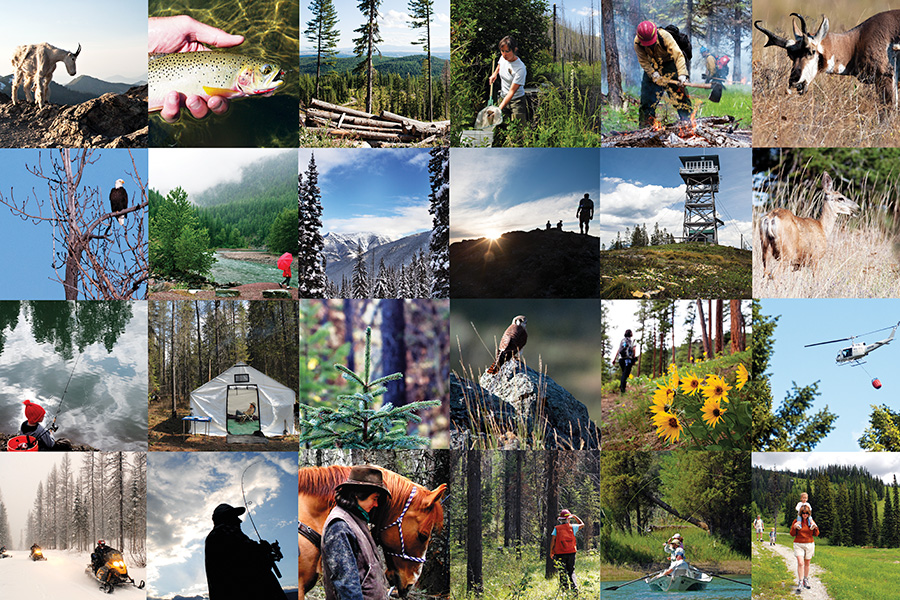A newly minted management plan for the Flathead National Forest to guide a wide range of uses on 2.4 million acres will face opposition as a pair of Montana conservation groups announced their intent to challenge the plan, saying it “abandons key measures that have protected grizzly bear and bull trout habitat on the Forest for more than two decades.”
Swan View Coalition and Friends of the Wild Swan announced they have notified the U.S. Forest Service and the U.S. Fish and Wildlife Service their plans to file a lawsuit, which centers on allowances within the plan for new road building and other wildlife disturbances in wildlife habitat.
Flathead National Forest Supervisor Chip Weber said the plan considered the needs of all stakeholders, including timber interests, hikers, horsemen, mountain bikers, snowmobilers, cabin owners, boaters, anglers, grizzly bears, bull trout, and nearly everyone else with a stake in the management of public lands on the Flathead National Forest.
The plan was the result of four years of collaborative effort, Weber said, and replaced the 1986 plan in order to update the long-term strategic vision for forest management.
“We greatly appreciate the commitment of interested participants who’ve provided important contributions toward the development of the land management plan through their participation in the planning process,” Forest Supervisor Chip Weber said. “We look forward to working with our partners and public in the years ahead in utilizing the vision in this land management plan to reach strategic objectives.”
The Flathead National Forest recently released its Record of Decision for the Land Management Plan, incorporating management direction for the Northern Continental Divide Ecosystem grizzly bear habitat.
The two conservation groups have long remained critical of the forest plan, saying it rolls back protections for threatened and endangered species like bull trout and grizzly bears.
Keith Hammer, chair and founder of the Swan View Coalition, formed the group during the contentious period when the 1986 forest plan was being crafted. He said the new plan does less for fish, wildlife and habitat, taking a step backwards in terms of conservation.
“The Flathead is abandoning road removal, the true habitat restoration it says is helping recover grizzly bears and bull trout,” Hammer said. “It is replacing that with road building and logging and trying to call that restoration. We don’t buy it and the science doesn’t support it.”
In the Record of Decision, Weber wrote, “Given the improved condition of the NCDE grizzly bear population and its habitat, I find that it is not necessary to further reduce public access by about 518 miles.”
“There is always a trade-off when you close roads,” Weber stated.
Among its many proposals, the forest plan recommends 190,000 acres of land for inclusion in the National Wilderness Preservation System, including the Jewel Basin, the Tuchuck-Whale areas and additions to the Mission Mountain, Great Bear and Bob Marshall wilderness areas.
It provides for timber output of approximately 28 million board feet annually on 637,419 acres of “suitable timber base.” In comparison, the 2006 proposed revision plan identified 529,000 acres of “suitable timber base” and the 1986 plan identified 707,000 acres.
It identifies 22 rivers and streams — stretching a total of 276 miles — that are eligible for protection under the National Wild and Scenic Rivers System. Those streams include the Danaher from the headwaters to Youngs Creek; Big Salmon from Lena Lake to the South Fork Flathead River; and Spotted Bear, from the headwater to the South Fork Flathead River.
Because the Flathead National Forest spans a large chunk of the Northern Continental Divide Ecosystem, home to the largest population of grizzly bears in the Lower 48, the plan also includes a separate document that will be instrumental in guiding management of the bears when grizzlies are delisted from the Endangered Species Act.
“By abandoning the cap on new roads and eliminating the provisions to remove roads, this new plan harms bull trout and native aquatic life,” Arlene Montgomery of Friends of the Wild Swan said. “When road culverts inevitably fail they dump sediment into streams that will clog spawning beds. The Flathead doesn’t have the budget to maintain its existing road system, so they should be reducing the miles of road on the Forest instead of degrading habitat for wildlife and fish.”
